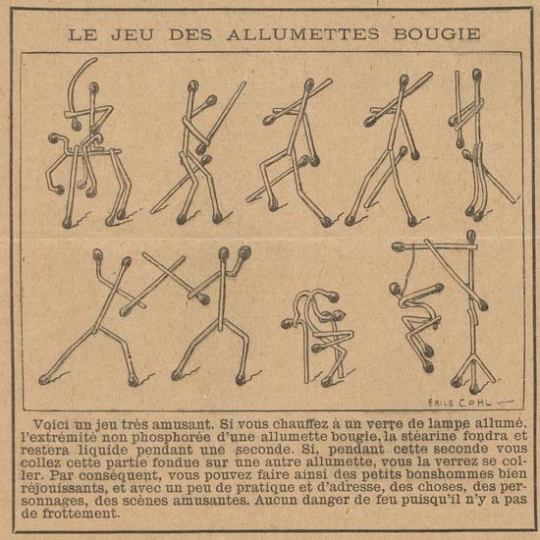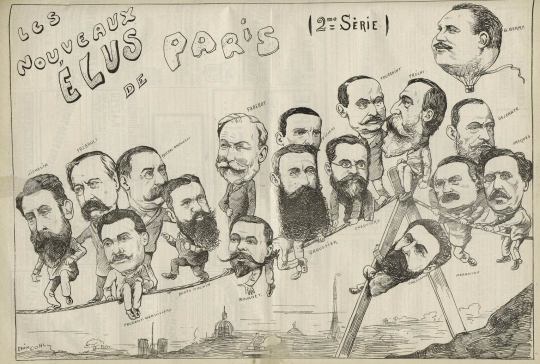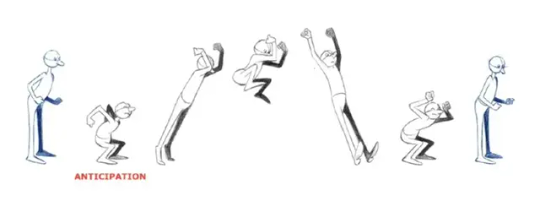Text
Emile Cohl
Emile Cohl was born in 1857, his father was a rubber salesman. In 1863, when he was 6 years old, he was sent to the boarding school Institute Vaudron. This is where it was discovered he had a talent for illustration and was encouraged for it, however due to the Franco-Prussian War in 1870 his father had to shutdown his rubber factory. This led Cohl to be sent to a less expensive boarding school, Ecole Turgot, where he would attend marionette theaters and work as a poltical caricaturist. In 1878, he became an assisstant under Andre Gill, a famous french caricaturist, who would become Cohl's mentor and close friend. Cohl would become instantly famous when he would make cartoons insinuating that the then French President Patrice MacMahon was the reason the french lost the Battke of Sedan agasint Prussian forces. This led him to be fined and imprisoned for 10 days, on the 11th of October 1879. This skyrocketed Cohl's popularity.

In 1907, Cohl changed careers at the age of 50, becoming a scriptwriter for the film company Gaumont. He was inspired by John Stuart Blackton, who had already made several animated comedies, and studied his work in order to make his own animated films. Cohl deviated from Blackton's methods, while Blackton would draw with a chalkboard and chalk, Cohl drew each frame individually on hundreds of pieces of paper. This would make Cohl's method far closer to modern animation methods compared to Blackton's. In 1908, Cohl made his first animated movie "Fantasmasgorie" and it is considered the first genuine animated movie. It's success paved Cohl's way into making an abundance of animated films for various studios,even travelling to America for work.

9 notes
·
View notes
Text
Illustration and Animation Practice - Week 1 Life Drawing







0 notes
Text
Anticipation, The second principle of Animation.
In a nutshell, anticipation is the persistent sense that something "new" is soon going to happen. You need to keep watching to find out what that is. The 12 principles of animation depend heavily on anticipation because of this. If anticipation is not applied, the item may move in an abnormal way. The item will move in advance as a preliminary action before traveling at all (often quick or decisive movements). The anticipation phase serves to reserve energy for boosting movement.

A very simple yet effective technique for letting your audience know that something is about to happen is to create anticipation. This can enhance the enjoyment of watching animation.
However, expectation serves to enhance movement interest rather than undermine the movement's "surprise" in any way. It might be viewed as a means of heightening the tension (for the impending action). Because of this, viewers of the animation will focus more on the action and not miss it.
Moving first in the opposite direction is the traditional strategy for anticipation. It will be a natural movement for the character to first lean slightly to the right if they are about to move to the left.
Physically, the idea of anticipation can be used to describe how an item prepares for motion and stores kinetic energy before it begins to move (as in the aforementioned cases).
However, timing, dynamics, velocity/acceleration, and the contour of the movement are some of the crucial elements animators need to focus on while using anticipation. In order for the movement to appear realistic to the spectator, the expectation and movement must coincide.
Many animated films, particularly superhero flicks, have this animation problem that may be pointed out. Animators frequently want superheroes to be "faster" and "stronger" to give the impression that they possess abilities. This is entirely comprehensible. However, if we overuse anticipation during the animation process, the character's movement will lose its organic logic. This frequently occurs in cartoons where the buildup is too brief or unimportant.
This flaw in animation can be pointed out in many animated films, especially superhero movies. To make superheroes look like they have superpowers, animators often want them to be "faster" and "stronger". This is completely understandable. However, during the animation process, if we use anticipation unreasonably, the character's movement will lose its natural logic. This often happens when the anticipation is too short or insignificant in the cartoons.
0 notes
Text
Artist Research - Caroline Leaf
Caroline Leaf is a multi award winning Artist and Animator, who has created a variety of animated experimental films in her career, creating "The Street", "The Owl Who Married a Goose" and "Kate and Anna McGarrigle". Although she has authored few films, her ability to create compelling narratives, her innovative and creative process utilizing any material she can to create her animations, and her open minded nature has led to her becoming a recognized and respected artist.
Attending a 1 year animation course at Harvard University in 1968, she learnt to use Animation not as an industry professional, but as an artistic form of self expression. This is where she learnt how to draw using essentially anything that could be manipulated into forming images. Leaf was not taught about film language or editing, rather the class was often left alone to discover their owl solutions.


Leaf's first film, "Sand or Peter and the Wolf" was made from a jar of beach sand poured onto a light box. This created a distinct and shadowy feel to her work, which would inspire her future creative endeavors. Her following films are continued refinements of these techniques. Leaf's techniques did not align with traditional team productions, because of this she mostly worked solo, being sole director and animator on her projects.
Leaf's films are known for their emotional story telling and distinctive vocative style. the imagery is rough and unnatural in some of her work, simplistic and childlike in others. In 1984 the Oscars placed leaf's "The Street" in second place when judging all animated films ever made, winning over Disney and other corporate productions.
0 notes
Text
Bouncing Ball Animation Exercise

0 notes
Text
Squash and Stretch - The first principle of animation
Squash and stretch is the first principle of animation, as coined by the original animators of Disney Animation. It is the application of dynamic shapes to create a sense of flexibility and movement, the lack of which causes the movement of animation to seem stiff and unnatural. The most fundamental exercise of squash and stretch being the bouncing ball animation. Without squash and stretch the ball would seem two dimentional and fake.
Squash and stretch can also create a sense of material and texture. The more this principle is applied the more soft and bouncy the object appears, while the less its applied, the more hard and brittle. This means the animator also needs to understand the objects physical capabilities and how it typically moves to instill a sense of life to it.
Squash and stretch gives animators the ability to depict flexiblity and realism to their subjects. However its also important for animators to understand the capablities of their subjects to avoid their work becoming outlandish and over dramatic. Many animators follow a "feel it, dont see it" approach to this principle, where audiences should feel the implied motion but not be able to properly see it. Because of this objects and especially chararcters have to recover from the warped state quickly to avoid breaking the illusion. This creates a bouncy-ness to the movement without warping it.
0 notes